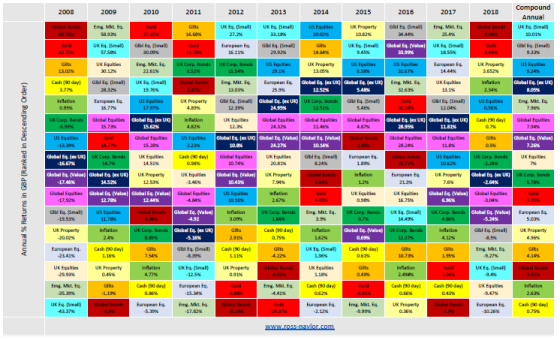
The Basics of Good Expat Investment Advice
What we will cover in this post
1 An introduction to expat investment advice
2 Rebalancing
2.1 What Is Rebalancing?
2.2 How Rebalancing Works
2.3 Benefits of portfolio rebalancing
2.4 Downsides of portfolio rebalancing
2.5 6 Portfolio Rebalancing Tips
2.6 Rebalancing – Conclusion
3 Diversification
3.1 The power of diversification: How to protect your expat retirement
3.2 Themes
4 Further reading:

An introduction to expat investment advice
Historically, expat investment advice has been characterised by the focus on the sale of a financial product, e.g. a pension plan or an investment fund.
While products are, obviously, a necessary feature of a wider holistic financial planning strategy, good quality expat investment and retirement advice encompasses much more than simply selling products.
In this post I will address the main issues that you should consider when planning your investments.
Rebalancing
What Is Rebalancing?
Rebalancing is the process where the weightings of the investments within a portfolio are reset back to their original levels.
It involves periodically buying or selling assets within a portfolio in order to maintain an original or desired level of asset allocation or risk.
For example, say an original target asset allocation was 60% stocks and 40% bonds (i.e. 60/40).
If the stocks performed well during a given period, it could have increased the stock weighting of the portfolio to 70%. The investor may then decide to sell some stocks and buy bonds to take the portfolio back to the original target allocation of 60/40.
Alternatively, in a period of market stress (e.g. 2008/2009 or the current Coronavirus crisis), where stocks fall sharply and their weighting of the portfolio drops to 50%, the investor could decide to sell some bonds and buy stocks at the lower level and take the portfolio back to the original 60/40 allocation.
How Rebalancing Works
There are various approaches to rebalancing with Periodic or Calendar Rebalancing being the simplest approach.
Periodic/Calendar Rebalancing
This strategy involves analyzing the investment holdings within the portfolio at predetermined time intervals and adjusting to the original allocation at a desired frequency.
Monthly and quarterly reviews are typically preferred, as a yearly approach would potentially allow for too much portfolio drift in the meantime.
The ideal frequency of rebalancing should be based on time constraints, transaction costs and allowable diversion from the target.
A big advantage of calendar rebalancing over more responsive methods is that it is significantly less time consuming and costly for the investor since it involves less trades and is carried out at pre-determined dates.
The downside to calendar rebalancing, however, is that it does not allow for rebalancing at other dates even if the market moves significantly.
Dynamic Rebalancing
A more dynamic approach to rebalancing focuses on the allowable percentage holding of each asset within a portfolio.
Every asset class, or individual security, is given a target weight and a corresponding tolerance range.
For example, an allocation strategy might include the requirement to hold 30% in domestic equities, 30% in international equities and 40% in government bonds. Within this portfolio, each asset class will have a band of, say, plus or minus 5%.
In this example, domestic and international equities could both fluctuate between 25% and 35%, while 35% to 45% of the portfolio would need to be allocated to government bonds.
When the weight of any one holding moves outside of the allowable band, the entire portfolio would be rebalanced to reflect the initial target composition.
The advantage with this method is that you are constantly buying low and selling high and potentially taking advantage of opportunities often in a whipsawing market.
Additionally, in calmer markets, you may not need to touch your portfolio for some time.
Benefits of portfolio rebalancing
It helps to balance risk and reward
Ultimately, asset allocation is all about balancing risk and reward.
Inevitably, over time, some asset classes (usually stocks) will perform better than others. This can cause your portfolio to be skewed towards an allocation that takes too much risk or too little risk based on your financial objectives.
This is great if the market continues to rise but you would then see a more pronounced decline in your portfolio when the market experiences a sharp correction.
Discipline
Rebalancing imposes a level of discipline in terms of selling a portion of your winners and putting that money back into asset classes that have underperformed.
This may seem counterintuitive but all markets evolve over time.
What is hot at one time does not remain so. Remember back in the 1990’s when tech stocks were all the rage? Those that did not rebalance during those times would have seen big losses when the bubble eventually burst.
Rebalancing can help save investors from our own worst instincts as it is often tempting for us to let our top performing holdings and asset classes run when the markets seem to keep going up.
Ideally investors should have a written investment policy that outlines their target asset allocation with upper and lower percentage ranges. Violating these ranges should trigger a review for potential portfolio rebalancing.
Rebalancing helps you stay on track with your financial plan
Investing success is not the be all and end all. It is simply a tool to help ensure that you meet your financial goals and objectives.
A properly constructed financial plan will contain a target asset allocation and an investment strategy tied to your goals, your timeframe for the money and your risk tolerance.
Periodic portfolio rebalancing is vital to maintaining an appropriate asset allocation that is in line with your financial plan.
It is a great way to take advantage of falling markets.
As investors we all know the theory that we should buy low and sell high and we all plan to do so.
“Everyone has a plan until they get punched in the mouth”.
Mike Tyson
However, when markets are crashing as they did in 2008/2009 or during the current Coronavirus crisis, actually pulling the trigger and putting new money into the market is difficult.
Having a written rebalancing strategy in place (or even better, a fund that does it without you even having to act) allows you to more easily take advantage of such rare buying opportunities.
Downsides of portfolio rebalancing
Selling winners
One of the disadvantages of rebalancing is that sometimes you cut the legs out from under the asset class before it has finished its bull run.
Tax
There can be important tax considerations in rebalancing when investors do it in taxable accounts. The tax impact isn’t as relevant in tax advantaged accounts like pensions or ISAs.
Personal tax can be avoided if the assets are rebalanced within a multi-asset fund.
Costs
The buying and selling of assets typically incurs costs. Unnecessary rebalancing therefore leads to unnecessary costs.
6 Portfolio Rebalancing Tips
1. Set a target asset allocation
Your asset allocation should be an extension of a target asset allocation from your financial plan and/or a written investment policy.
This is the target asset allocation that should be used when rebalancing your portfolio.
2. Establish a time frame to rebalance
Ideally you are reviewing your portfolio and your investments on a regular basis.
As part of this process you should incorporate a review of your asset allocation.
This might be semi-annually for example. I generally suggest no more frequently than quarterly. An exception would be after a precipitous move up or down in the markets.
3. Take a holistic view of your portfolio
Ideally, when rebalancing your portfolio take a total portfolio view. I.e. look at all of your investment accounts, including insurance bonds, investment platforms and pensions.
Doing so will allow you to be strategic and tax-efficient when rebalancing. It will also ensures that you are not taking too little or too much risk on an overall basis.
4. Incorporate new money
If you have new money to invest, take a look at your asset allocation first. Then use these new funds to shore up portions of your asset allocation that may be below their target allocation.
5. Don’t think you are smarter than Mr. Market
I know it is tough to sell winners and then invest that money back into portions of your portfolio that haven’t done as well.
However, portfolio rebalancing is part of a disciplined investment process.
It can be tempting to let your winners run, but too much of this can skew your allocation too far in the direction of stocks and increase your downside risk.
If you think you can do better than the collective knowledge of the market, trust me, you can’t.
Ask yourself, how devastating the impact of being wrong could be?
Just ask those who bought into the mantra “…it’s different this time…” before the Dot Com bubble burst.
6. Use autopilot
For most investors, the best solution is to invest in a single fund that is well diversified, holds multiple assets and that rebalances dynamically.
This removes any personal tax issue as the assets are bought and sold within the fund.
It removes the need to make active decisions. You don’t have to face the test of willpower in deciding to sell an asset that is performing strongly. You don’t have to pull the trigger on buying stocks when the market has dropped 30% and no one knows what is going to happen next.
Finally, it is the simplest solution and simplicity, in my view, is one of the most underrated factors in investing.
Rebalancing – Conclusion
Regular portfolio rebalancing helps reduce downside investment risk. It also ensures that your investments are allocated in line with your financial plan.
It also can help investors impose, directly or indirectly, an important level of discipline on themselves.
While it is possible to go without rebalancing a portfolio, this would generally be ill-advised.
Rebalancing gives investors the opportunity to sell high and buy low, taking the gains from high-performing investments and reinvesting them in areas that have not yet experienced such notable growth.
Diversification
The power of diversification: How to protect your expat retirement
“Holding a diversified portfolio of asset classes and investments means you don’t have to try to pick and choose the best performing section each year (which is impossible to do anyways).”
– Ben Carlson @awealthofcommonsense
This chart is one of my favourite ways of demonstrating the importance of diversification for those who are thinking about retirement or who have already hung up their spurs.

Going back to the financial crisis in 2008, it shows the annual returns for 15 different asset groups, including stocks in different regions and with varying market capitalisations, both corporate and government bonds, cash, gold and real estate. For comparison, I have also added inflation figures to the mix.
Themes
If we dig into the data, some interesting themes emerge:
Just because an asset performed well in any given year, doesn’t mean that it will continue to do so. Since 2008, there were 15 instances where an asset in the top 3 performers one year was also in the bottom 3 either the following year or the preceding year.
Cash isn’t king. There have been a couple of years where stocks performed poorly and holding cash paid off. During the financial crisis and last year (2018) being good examples. This is why holding a couple of years’ worth of cash is so important if you are in retirement. It means that if markets do fall, then you don’t have to sell declining assets to fund your lifestyle.
However, over the medium to long term, the data shows that cash is a poor investment as it loses value relative to the rising cost of living.
No rhyme or reason. Over the 11 years in the chart, 9 different assets held the top performer slot. Also, there was only one occasion, 2012 and 2013, where the top performing asset was the same in consecutive years.
This is because different assets and investments have their own characteristics and perform better or worse in different economic environments.
The power of diversification is that you don’t have to try to pick and choose which sector will perform best in any given year. Done correctly, you should always own some assets that are performing reasonably well.

Talk to an Expert
Investing as an expat can feel overwhelming. Different tax rules, unexpected residency complications, risky offshore products, and conflicting advice often leave people unsure where to begin — or whether they’re making the right decisions at all.
I’m Ross Naylor, a UK-qualified Chartered Financial Planner and Pension Transfer Specialist with nearly 30 years’ experience helping British expats build simple, globally diversified, low-cost investment plans that grow steadily without unnecessary risk or complexity.
I firmly believe your location in the world should never be a barrier to expert, impartial and transparent financial advice you can trust.
Whether you’re unsure which accounts to use overseas, how to avoid high-fee investment bonds, how currency affects returns, or how to build a long-term plan that survives future moves, I’ll help you get the basics right so your money works for you — not against you.
Book a confidential consultation
